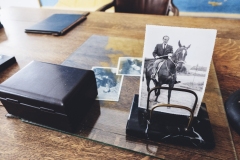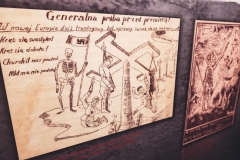Oskar Schindler’s Enamel Factory in Krakow, is a museum located in the administrative part of the former enamel factory Deutsche Emailwarenfabrik (DEF), owned by Oskar Schindler.
Oscar Schindler (1908-1974) was a German businessman and industrialist known for saving 1,200 Jews from the Holocaust. He did this by employing them in his enamel factory. Schindler was a member of the German Nazi party “Nationalsozialistische Deutsche Arbeiterpartei” (NSDAP) and an agent of the German military intelligence service Abwehr. Schindler used his contacts in Abwehr when he protected the Jewish workers from deportation and execution in concentration camps.
Before DEF, this was a factory called “Rekord”. Enamel products and sheet metal products were manufactured there. The factory was founded in 1937 by the Jewish entrepreneurs Michał Gutman, Izrael Kohn and Wolf Luzer Glajtman. The company underwent several changes in ownership, and the economy deteriorated. In June 1939, the company filed for bankruptcy. After the outbreak of World War II and the Germans arriving to Krakow in the fall of 1939, Schindler took over the factory and changed its name to Deutsche Emailwarenfabrik (DEF). The factory continued to produce enamel products, but a weapons production department was also established.
Initially, most of the workers were Poles, but over time, more and more Jewish workers were recruited through the employment agency in the ghetto. In 1944, approx. 1100 Jews worked in the factory. The working conditions, especially at the enamel furnaces and sulfuric acid vessels, were very hard.
When the ghetto was closed in 1943, the surviving Jews were moved to a labor camp in Płaszów. Schindler applied for permission to establish a subcamp to the Płaszów camp on a plot of land he had purchased near the factory. The workers from the factory and three nearby companies lived in barracks in Zabłocie, which were surrounded by barbed wire and watchtowers. The food was better than in the Płaszów camp thanks to the cooperation with the Poles. Schindler’s efforts meant that the inspections, carried out ( among others) by Hauptsturmführer (Captain) Amon Göth, were not as onerous for the factory workers. After Płaszów was converted into a concentration camp, the prisoners from Zabłocie were placed under permanent SS control. The workers initially had a working day of twelve hours in two shifts, but this was later changed to eight hours in three shifts.
In July 1944, as the Red Army approached, the SS began to close the concentration camps that were located farthest to the east. The prisoners were evacuated to Auschwitz and Gross-Rosen. Schindler then managed to convince Göth, among others, to let him move the factory and the workers to Brünnlitz (part of Gross-Rosen) in the Czech Republic. In this way, Schindler protected the workers from being murdered in the gas chambers. The camp was liberated by the Red Army on May 8, 1945.
About 1,200 prisoners from Schindler’s factory survived thanks to his efforts to protect them from the Holocaust. At the end of the war, he had nothing left of his fortune, most of which was used for bribes.
In 1963, Yad Vashem (Israel’s memorial center for Holocaust victims and heroes) awarded Schindler the “Righteous Among the Nations” award. This award is given to non-Jews who played an active role in saving Jews during the Holocaust. Oskar Schindler died in West Germany on October 9, 1974 and was buried in the Catholic cemetery in Jerusalem.















